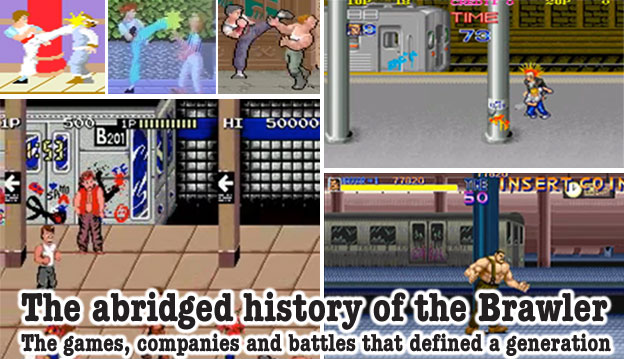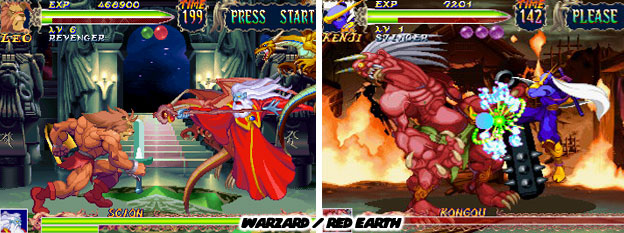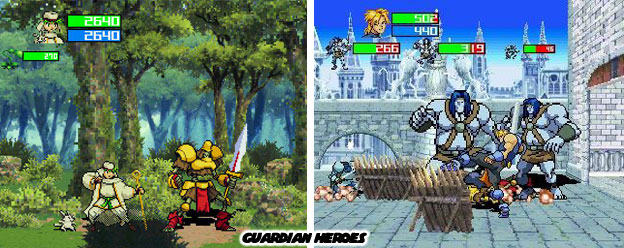
Halfway through the decade gamers would see the best that the genre had to offer. Capcom cemented their legacy with two of the best arcade titles ever released. The first one that I mention was not a brawler, Red Earth / Warzard was a fantasy-based fighting game. Unlike Konami’s Monster Maulers or Banpresto’s Metamoqester which allowed two players to combat monsters Warzard was a strictly one-on-one fighting game. It was actually the first title created to show off their new CPS-III game engine. This was something important because most in the industry and most fans had expected Capcom to show off the advanced colors, effects, animations and larger sprites that the engine could render with Street Fighter III. Capcom did release SF III on the CPS-III a few months later, but visually it was not any more impressive than Warzard.
Warzard had some RPG elements in that progress and experience made in the game could be saved on the system. In addition to leveling up armor, weapons and health bars the game also used a “magic” system that was invoked as a special attack. The four main characters, a ninja named Mukuro, an anthropomorphic lion named Leo, a witch named Tabasa and a martial artist named Tao were among the best character designs in any fighting game The redefined the archetypes from which they were based on. The villains in the game were equally amazing.

The game featured a sprite-scaling system for the sprites but when the camera zoomed in and out of the action it was not as extreme as the Sega games, the shift was slight and did not make the sprites appear flat at all. The game had a fun story and even offered multiple endings and a hint for a never to be produced sequel. It gave gamers a reason to replay the title Unfortunately the game was very rare and few arcades ever had one of their own. Of the dozens and dozens of arcades I’ve had the fortune of visiting I’ve only seen one Warzard cabinet. But I digress, I was supposed to be talking about brawling titles.
The other game Capcom released in 1996 was built on the older CPS-II engine. It was arguably the greatest brawler they ever developed and a contender for greatest brawler of all-time. Dungeons and Dragons: Shadow over Mystaria was a follow up to their previous D&D title, the Tower of Doom. It improved on the earlier title on every level.
The weapon upgrades, magic and combat systems were preserved from the previous D&D title as were the branching paths. The game was a bit longer than the original while the diversity of locations and opponents had increased. An entirely new cast of playable characters was introduced in Shadow over Mystaria including a Cleric, Dwarf, Elf and Thief. The characters had more than cosmetic differences between them, their move sets and abilities were vastly different. The Thief was a fast character that could jump off of walls and detect traps, they appeared to players as flashing signals to avoid. A group that played without a thief would end up walking blindly into traps, like having rocks drop on them from above. Just as a group that played without a Cleric would find it harder to fight undead characters or heal themselves without the aid of magic potions.

Shadow over Mystaria demonstrated how if the brawler were designed properly then it could be the perfect action-RPG. Players had real-time fights, real-time inventory management and reason to work as a team in order to survive in a fantastic but dangerous world. The artistic stylizations that sprites provided added an additional layer of appeal to the game. No 3D MMO, with its point-and-click mechanics and canned animations could ever hope to match the actual interactivity and gameplay that the brawler provided. Yet Shadow over Mystaria had a rival that year, a game that some would argue as being an even better experience and for many the greatest brawler ever released.
Treasure had a short but memorable list of games at that point in the market. The independent studio was known for their original ideas and amazing animation. Guardian Heroes was their entry into the fantasy brawling genre. The game was released on the Sega Saturn and took advantage of the 32-bit processor and increased storage capacity that CD media had over the 16-bit cartridges. Actually Treasure had pushed the hardware past its breaking point, as the game often allowed so many characters on screen and effects to be happening at once that the Saturn would slow down in the middle of the most frenetic battles. Despite the slow-down issues the game was so well designed and executed that it caught players and reviewers completely by surprise.
Players could choose from one of five character types, a warrior named Samuel, a female knight named Serena, Genji the ninja, a magician named Randy and a cleric named Nicole. Each of course with their own strengths, attacks, magic and weaknesses. Players learned what character combinations worked best for them and their style of gameplay. The game, like the best brawlers worked best with multiple players. Treasure found a way to give single players that experience by providing them with a computer controlled Undead Warrior. This character could be set to attack, defend or even go berserk by players. Being able to know when to trigger the teammate abilities was crucial to beating some of the harder bosses. The game actually began right in the middle of the action where soldiers from the kingdom were trying to recover a magical sword that Samuel had gotten. Players had to quickly learn the control and magic system while a tavern they were staying in was burning to the ground. The pacing between story and action moments was well put together.
The gameplay took place on a 2-dimensional plane rather than on an open field as in most brawlers. The reason for this was understandable. Characters could perform complex combo attacks on opponents, similar to fighting games, which required advanced commands. In a typical brawler if a player did not properly line up an attack after entering the command then it was a wasted strike. Keeping opponents on the same plane eliminated those missed opportunities. However that also meant that wave of opponents would also be able to approach from the front and back on the same plane. To give players some freedom, Treasure made it so they could jump up to two levels into the background to fight or escape opponents. It could also be done to spread out the sometimes chaotic action. No other brawler had ever offered this gameplay mechanic before. But to be fair the fighting game Fatal Fury had featured a similar mechanic years earlier.

Guardian Heroes game offered many paths to follow. It was possible for gamers to have dozens of different experiences each time they played. Players could even spend points that they had earned by defeating opponents to increase their stats and abilities. Players learned to carefully balance their physical and magical attacks and take advantage of the environment and opponents. If multiple characters were near each other then players could perform a single lightning, ice or fire attack and let that attack travel like a shockwave through all of the careless enemies. Players could rack up scores of experience in the process and extend their magical attacks. Players could even take advantage of careless enemy sorcerers. If an opponent activated a healing disk for enemies to stand on and replenish their health then players could knock opponents off of that disk and give themselves the energy instead. In other videogames enemy magic seemed to only help enemies. In this game it applied to either side
The best part of the game was that every defeated opponent, from muscle bound thieves, to demons, giant robots, sorcerers, plant monsters and boss characters could be played as in a bonus fighting game. It was more like a battle royal as up to six characters could take the field at once. Some of the characters were difficult to unlock because they often did not stick around long enough to be beaten before a cut-scene loaded. Players learned to work together and take out characters as fast as they could so they could play as them in the bonus game. To say that my brothers and I played a hundred hours or more securing the characters in the Saturn’s internal memory was an understatement. Guardian Heroes was the brawling experience we had all been waiting for only we did not know it.
Treasure appeared to come out of nowhere and set the standard for animation, character and level design, control, story and even music for every console brawler yet to come. What many players did not realize was that Treasure had built Guardian Heroes on the legacy of their team. The studio was composed of former Konami employees, then known as “Star Team” for their ability to crank out hit after hit. People that had worked on their best arcade brawlers including Aliens, the Teenage Mutant Ninja Turtles, Vendetta and the Simpsons had finally returned. When they were not bound by a license and allowed to develop an original brawler then they absolutely flourished. Not simply one of the greatest brawlers ever made but one of the greatest videogames ever made. Unfortunately many players did not get a chance to experience the title when it first came out. Because it was on the Saturn console rather than in the arcade meant that it would not get the exposure that it deserved. Thankfully Xbox Live would be available some 15-years later to give a whole new generation a chance to experience it. However for fans of the arcade brawler the genre seemed to have peaked in 1996. The industry went from a few great titles every year to a few years between great titles. Find out about 1997 and Capcom’s last sprite-based arcade brawler in the next blog. As always if you enjoyed this blog and would like to sponsor me please visit my Patreon page and consider donating each month, even as little as $1 would help make better blogs and even podcasts!

Thank you for writing this series and all the hard work you put in overall highlighting obscure and near forgotten fighting games. I have discovered plenty of cool gems by following your blogs and each post is a real treat.
ReplyDeleteQuestion: Have you considered teaming up with any retro-gaming type website or podcast? Your knowledge of fighting games in particular must be near unparalleled and I'd love to hear you share your observations on a podcast or site like Retronauts, HardcoreGaming, VGMpire or similar. That post you made back in the day about simple lessons for designing an iconic Street Fighter character was just too good. I do believe your expertise and passion deserves a larger audience than the quiet neighborhood this blog provides. Doing a guest feature at a wider outlet could also draw in new readers if you're thinking about setting up a patreon. I will at least be lobbying for such an occasion on your behalf. :)
Anyways, much appreciation for the work you put in, this blog is a delight!
Captain N2,
DeleteThanks for the kind words, I'm glad you are enjoying the series so far. I didn't really give too much thought to podcasting because I've been so busy at work. Also those gaming podcasts all have their set hosts and guests. I don't think they know of me or would want me to be on their show. I finally am getting around to doing some recording and I am going to start a podcast myself and set up a Patreon if anyone wants to help. Thanks for keeping me inspired to keep on writing!
You are too humble my friend. Any show on the history of beat-em-ups or Capcom/SNK would be lucky to have you. I also greatly enjoy how you often reach outside of the gaming sphere to connect the content to its various forebears in movies, comics and martial arts. Gaming culture and journalism can often be too insular and I appreciate learning of the sources and connections you bring up. Retro gamers definitely needs to keep your blog on their radar. For me it's one of the essential daily stops. :)
ReplyDeleteAmazing article - thankyou!
ReplyDelete